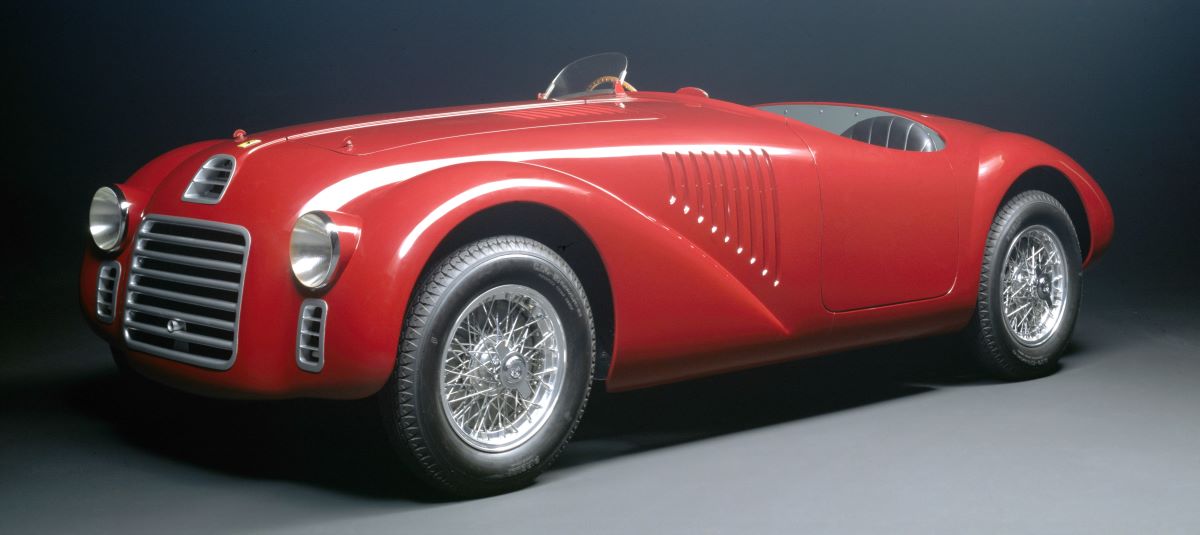
1947 125 S
This was the very first car to wear the Ferrari badge. The V12 engine was designed by Gioachino Colombo with contributions from Giuseppe Busso and Luigi Bazzi. Sport and competition versions of the 125 S were built with different bodywork although the chassis and running gear of the cars remained basically identical. The 125 S’s debut on the Piacenza circuit was, in the words of Enzo Ferrari himself, “a promising failure.” In fact, Franco Cortese had to pull out because of a problem with the fuel pump while leading the race. However, over the following four months, the 125 S was back on the track 13 times, winning six of its races.

Engine
- Motore………………….anteriore, longitudinale, 12V 60°
- Bore/stroke…………….55 x 52.5 mm
- Unitary displacement…124.73 cc
- Total displacement……1496.77 cc
- Compression ratio……..9.5 : 1
- Maximum power……….87 kW (118 hp) at 6800 rpm
- Power per litre…………79 hp/l
- Valve actuation……….single overhead camshaft per bank, two valves per cylinder
- Fuel feed……………….three Weber 30 DCF carburettors
- Ignition…………………single spark plug per cylinder, two magnetos
- Lubrication……………..wet sump
- Clutch…………………..single-plate
Chassis
- Frame…………………..tubular steel
- Front suspension………independent, unequal-length wishbones, transverse leaf spring, hydraulic shock absorbers
- Rear suspension……….live axle, semi-elliptic springs, hydraulic shock absorbers, anti-roll bar
- Brakes…………………..drums
- Transmission…………..5-speed + reverse
- Steering………………..worm and sector
- Fuel tank……………….capacity 72 litres
- Front tyres…………….5.00 x 15
- Rear tyres………………6.00 x 15
- Type…………………….two-seater spider
- Wheelbase……………..2420 mm
- Front/Rear track…….1240 mm
- Weight………………….650 kg (dry)
Performance
- Top speed……………..210 km/h
1947 159 S
Developed from the 125 S whose engine was increased to 1903 cc by boring it out and working on the stroke. This model too was fitted out with a monocoque body or with separate mudflaps as more attention was now being paid to improving the aerodynamic penetration coefficient. It was used in only three competitions but brought the newly founded Ferrari its first international victory, the Turin Grand Prix won by Raymond Sommer in 1947.

Engine
- Type…………………….front, longitudinal 60° V12
- Bore/stroke…………….59 x 58 mm
- Unitary displacement…158.57 cc
- Total displacement……1902.84 cc
- Compression ratio……..8.5 : 1
- Maximum power……….92 kW (125 hp) at 6500 rpm
- Power per litre…………66 hp/l
- Valve actuation……….single overhead camshaft per bank, two valves per cylinder
- Fuel feed……………….three Weber 32 DCF carburettors
- Ignition…………………single spark plug per cylinder, two magnetos
- Lubrication……………..wet sump
- Clutch………………….single plate
Chassis
- Frame…………………..tubular steel
- Front suspension………independent, unequal-length wishbones, transverse leaf spring, hydraulic shock absorbers
- Rear suspension……….live axle, semi-elliptic springs, hydraulic shock absorbers, anti-roll bar
- Brakes…………………..drums
- Transmission…………..5-speed + reverse
- Steering………………..worm and roller
- Fuel tank……………….capacity 72 litres
- Front tyres…………….5.50 x 15
- Rear tyres……………..5.50 x 15
Bodywork
- Type……………………spider, two-seater
- Wheelbase……………..2420 mm
- Front track…………….1240 mm
- Rear track………………1240 mm
166 S
The 166 S was launched at the start of 1948 in both berlinetta and spider versions, both of which were built by Allemano. The berlinetta took victory in that year’s Mille Miglia, while the spider won the Giro di Sicilia.
Ferrari followed this success with a one-off prototype for a production car called the 166 Sport, but the name was quickly changed to 166 Inter, in which guise Allemano, Touring, Bertone, Ghia, Vignale and Stabilimenti Farina all went on to create some memorable interpretations, both open top and otherwise. These cars were custom-built to the owners’ specifications and the most common request was for the three carburettor option.

Engine
- Type……………………front, longitudinal 60° V12
- Bore/stroke…………….60 x 58.8 mm
- Unitary displacement….166.25 cc
- Total displacement……1995.02 cc
- Compression ratio……..7.5 : 1
- Maximum power……….81 kW (110 hp) at 6000 rpm
- Power per litre…………55 hp/l
- Valve actuation……….single overhead camshaft per bank, two valves per cylinder
- Fuel feed……………….three Weber 32 DCF carburettors
- Ignition…………………single spark plug per cylinder, two coils
- Lubrication……………..wet sump
- Clutch…………………..single-plate
Chassis
- Frame…………………..tubular steel
- Front suspension………independent, unequal-length wishbones, transverse leaf spring, hydraulic shock absorbers
- Rear suspension……….live axle, semi-elliptic springs, hydraulic shock absorbers, anti-roll bar
- Brakes………………….drums
- Transmission…………..5-speed + reverse
- Steering………………..worm and sector
- Fuel tank……………….capacity 80 litres
- Front tyres…………….5.50 x 15
- Rear tyres……………..5.50 x 15
Bodywork
- Type……………………two-seater berlinetta or spider
- Wheelbase……………..2420 mm
- Front track…………….1250 mm
- Rear track……………..1200 mm
- Weight………………….800 kg (dry, berlinetta)
Performance
- Top speed……………..170 km/h
166 Inter Sport
The Tipo 166 two-litre engine spawned a whole range of sports and single-seater models. In fact, the 166 Sport provided a crossover point between the two categories because, as the Ferrari catalogue of the day pointed out, it could be adapted for international races (hence the name Inter) for two-seater and single-seater sports cars. This was possible thanks to the fact that the lights and the mudguards could be attached and detached to suit the rules, making this a multipurpose model.

Engine
- Type……………………front, longitudinal 60° V12
- Bore/stroke…………….60 x 58.8 mm
- Unitary displacement…166.25 cc
- Total displacement……1995.02 cc
- Compression ratio……..11 : 1
- Maximum power……….96 kW (130 hp) at 6500 rpm
- Power per litre…………65 hp/l
- Valve actuation……….single overhead camshaft per bank, two valves per cylinder
- Fuel feed……………….three Weber 32 DCF carburettors
- Ignition…………………single spark plug per cylinder, two magnetos
- Lubrication……………..wet sump
- Clutch…………………..single-plate
Chassis
- Frame…………………..tubular steel
- Front suspension………independent, unequal-length wishbones, transverse leaf spring, hydraulic shock absorbers
- Rear suspension……….live axle, semi-elliptic springs, hydraulic shock absorbers, anti-roll bar
- Brakes………………….drums
- Transmission…………..5-speed + reverse
- Steering………………..worm and sector
- Fuel tank……………….capacity 75 litres
- Front tyres…………….5.50 x 15
- Rear tyres……………..5.50 x 15
Bodywork
- Type……………………two-seater spider
- Wheelbase……………..2420 mm
- Front track…………….1240 mm
- Rear track……………..1240 mm
- Weight………………….630 kg (dry)
Performance
- Top speed……………..215 km/h
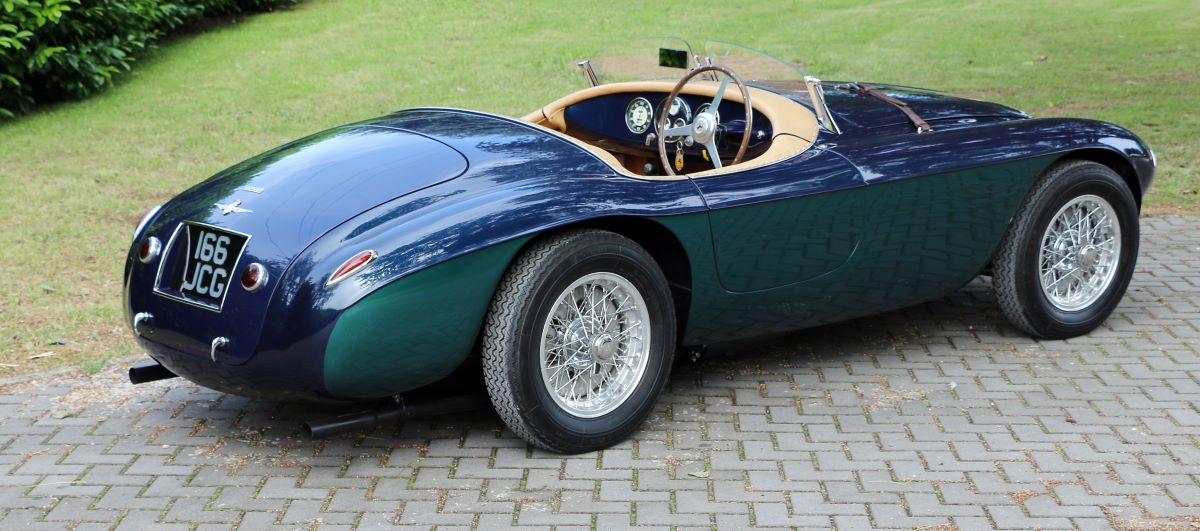
166 MM
Designed for long distance competition, the 166 MM took its name from one of the world’s most famous road races, the Mille Miglia, in which the Maranello cars were to triumph again and again.
Its coachwork was built by Touring using the “Superlight” method ensuring that the 166 MM was both extremely light and extremely dynamic whilst still maintaining significant structural stiffness. The 166 MM’s engine was also modified to suit the new rules so that it could run on “normal” commercially available fuel.
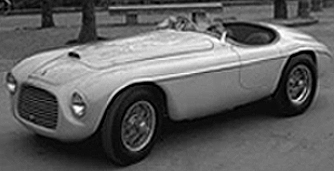
Engine
- Type……………………front, longitudinal 60° V12
- Bore/stroke…………….60 x 58.8 mm
- Unitary displacement…166.25 cc
- Total displacement……1995.02 cc
- Compression ratio……..10 : 1
- Maximum power……….103 kW (140 hp) at 6600 rpm
- Power per litre…………70 hp/l
- Valve actuation……….single overhead camshaft per bank, two valves per cylinder
- Fuel feed……………….three Weber 32 DCF carburettors
- Ignition…………………single spark plug per cylinder, two magnetos
- Lubrication…………….wet sump
- Clutch………………….single-plate
Chassis
- Frame…………………..tubular steel
- Front suspension………independent, unequal-length wishbones, transverse leaf spring, hydraulic shock absorbers
- Rear suspension……….live axle, semi-elliptic springs, hydraulic shock absorbers, anti-roll bar
- Brakes…………………..drums
- Transmission…………..5-speed + reverse
- Steering………………..worm and sector
- Fuel tank……………….capacity 90 litres
- Front tyres…………….5.50 x 15
- Rear tyres……………..5.50 x 15
Bodywork
- Type……………………two-seater berlinetta or spider
- Wheelbase……………..2200 mm
- Front track…………….1250 mm
- Rear track……………..1200 mm
- Weight………………….650 kg (dry, spider)
Performance
- Top speed……………..220 km/h
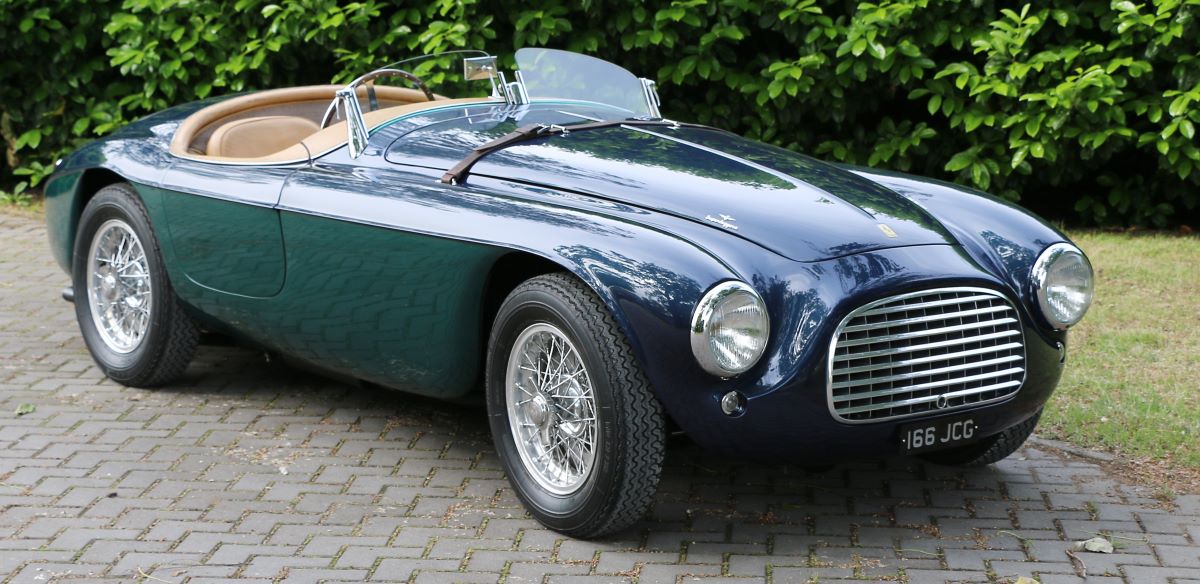
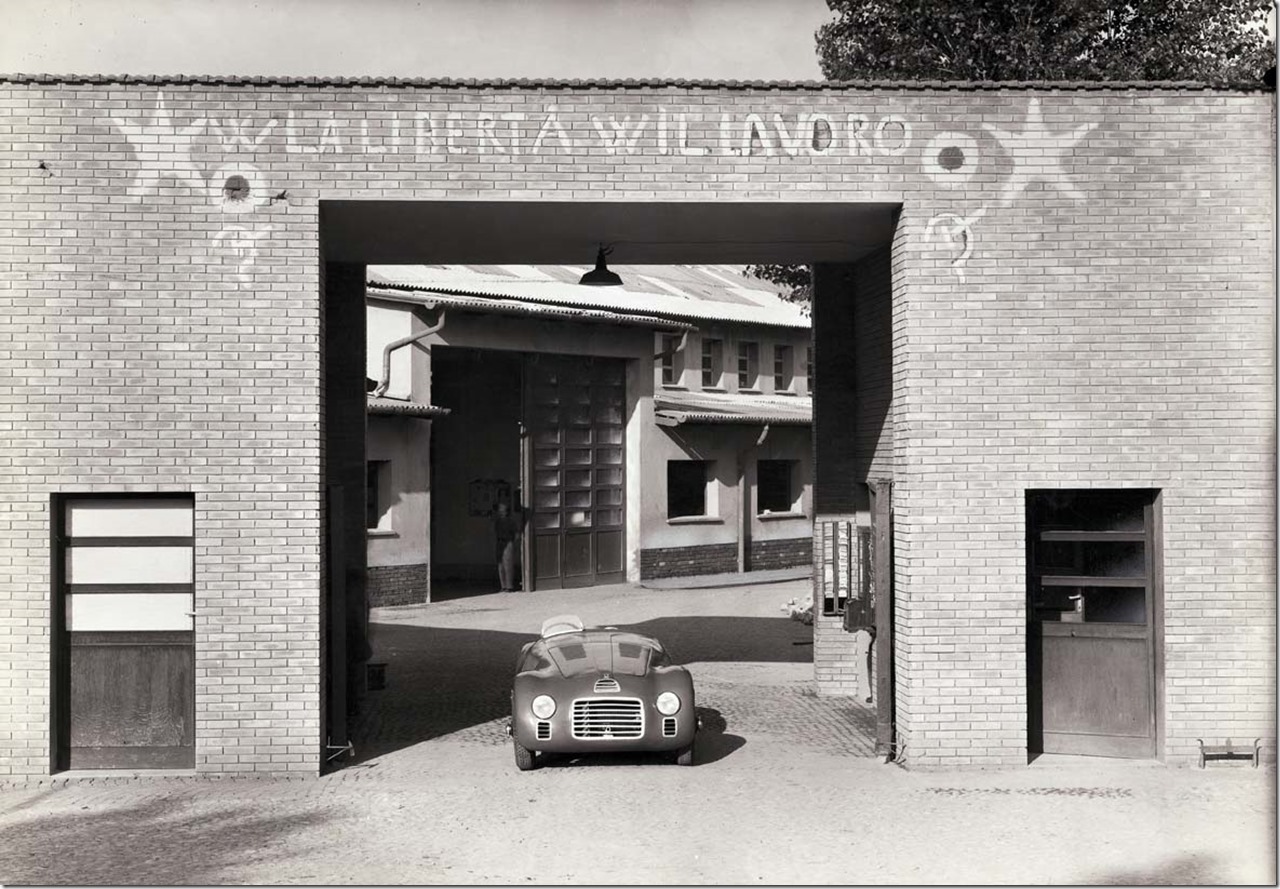

You must be logged in to post a comment.